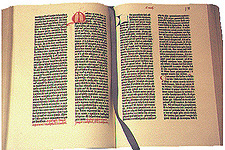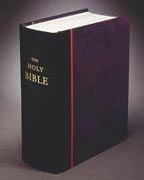In The Beginning...
The History of the Bible
By David R. Schneider
(c) 2002, 2003

Abstract:
The history of the Bible is presented: who wrote it, when it was written, what languages it was written in, and how it was compiled and passed through the ages to the present day. The views given here follow mainstream scholarly opinion, summarized for the lay reader and presented in a fashion that is easy to read. The results are certain to be of interest to anyone desiring to learn more about the creation of the Bible. Approx. 55 printed pages.
This is not a religious analysis of
Biblical content, and is not intended to follow any particular denomination’s
theology. As such, it would be of
interest to Catholics, Protestants, Jews and anyone else who has ever wondered
how the Bible came into being.
The introduction is presented below. You may click
on the links in the Table of Contents to see sections of the paper in HTML (web
page) format.
Table of Contents
| Chapter |
|
Page |
|
|
Section I |
|
|
1 |
Intro |
2 |
|
|
4 |
|
|
2 |
Overview: The
Words of Men |
7 |
|
3 |
In the
Beginning... |
14 |
|
|
|
|
|
|
Section II |
|
|
4 |
The Old Testament |
16 |
|
5 |
The Torah |
21 |
|
6 |
The Major
Prophets |
28 |
|
7 |
The Writings |
30 |
|
|
|
|
|
|
Section III |
|
|
8 |
Apocalyptic Times |
31 |
|
9 |
The New Testament |
33 |
|
10 |
The Pauline
Letters |
39 |
|
11 |
The Gospels |
42 |
|
12 |
Christian Canon |
44 |
|
|
|
|
|
|
Section IV |
|
|
13 |
Rabbinic Judaism |
46 |
|
14 |
And in the End... |
52 |
|
|
|
|
|
|
References and helpful links |
55 |
1. Introduction
An understanding of
the stories of the Bible is almost presupposed in many modern societies,
including the United States and Europe. The influence it has had on the development of Western
thought is undeniable. The shear
volume of references to the Bible has led me to wonder: How did it come into
being? Who wrote it? Why was it written? When
was it written? Why do different
people – even those with the same religious affiliation – read different
messages from the Bible? How can so
important a book be ambiguous?
Few of my friends
and acquaintances seem to have any idea of the sources of the written Bible. Whether they are Jewish, Catholic, or
Protestant, most simply believe that the Bible represents the word of God as
delivered to man. Their underlying
assumptions are that the Bible is immutable, infallible and its message not to
be questioned. The Bible has always
been and always will be. Its
inspiration is divine; its wisdom is timeless.
Perhaps it is not meant to be fully understood by man.
Yet, there is a
fascinating history here that goes so much deeper. As I studied the creation of the
collection of writings we know as the Bible, I uncovered many interesting
stories and unexpected twists. And
I learned that the Bible, as we know it, is very definitely the word of man.
The Bible as the
word of man? Is this not heresy
incarnate? Far from it! In fact, Biblical scholars of all
religions acknowledge the story I am about to tell you. While there is some disagreement on the
particulars, everything you are about to read is mainstream analysis. Many Bibles include much of what you
will read here either as preface or introduction (try looking, you’ll be
surprised).
Because of the
religious nature of the material included in the Bible, most people tend to
focus on the message rather that how that message came into being. Religious authorities may debate the
meaning of the words of the Bible, and find different ways to read identical
passages. Yet their common
underlying assumption is that those words are a direct reflection of God’s
instructions to mankind. Further,
the assumption is that these words have reached us through a pristine,
immaculate journey across thousands of years.
But it is the journey which is documented here; the meaning of the
passages themselves – whether literal or symbolic –is left to the reader of
the Bible.
In fact, the Bible
has been affected by decisions of many different individuals throughout the past
3000 years. These individuals were
perhaps influenced by the hand of God: this is certainly an opinion held by
many. Still, the significance of
man’s role in the development of the Bible cannot be understated. This will become clear as we cover the
many influences that are present. These
influences affect the actual words we read today, and go a long way towards
explaining the ambiguous nature of Biblical passages.
When I refer to the
Bible, I should clarify that I am referring to several different collections of
works that are referred to as the Bible. The
Bible is not so much a single book as it is a collection of short books. For my purposes here, I will frequently
refer to the following Bibles generally:
·
The Jewish Bible: This is the Old
Testament. Also called the Tanakh
(pronounced ‘ta-nock’).
·
The Catholic Bible: This is the
Old Testament and the New Testament. However the Jewish Bible and the Catholic Bible have
differences between the number and order of the Old Testament books. The Catholic Bible includes books not
considered canon by Jews.
·
The Protestant Bible: This
consists of the Jewish Old Testament and the Catholic New Testament, although
the order of the books of the Old Testament is somewhat different from the
Jewish Bible.
And there are more,
specific translated derivations...
·
The Septuagint: The ancient Greek
translation of the Old Testament from Hebrew.
·
The Vulgate (pronounced ‘vul-ga-tay’):
The Latin translation of the Old and New Testament from ancient Hebrew and Greek
sources.
·
The Kings James Version: The
English translation of the Vulgate.
·
The Revised Standard Version:
Revised English translation, based on the King James Version.
·
The New American Bible: English
translation of the Bible commissioned by Pope Pius XII and completed in 1970,
based on the Catholic books of the Bible (translated from the original languages
or the oldest extent form of the text).

How many different
Bibles are there? Which ones are
wrong? Can’t we just go back to the original, and skip the others?
As we will see,
there is no such thing as the original of the Bible in existence. There is not even a single original of
any portion of the Bible! All that
exist are copies, and frequently the copies are not in the original tongue of
the original author. (When you read
a Bible in English, you are reading a book that has been translated from
language to language, and there is substantial disagreement about important
points in the process amongst scholars.)
In this article, I
will cover the derivation of the key pieces of the Old Testament and the New
Testament. I will also discuss very
briefly the creation of the Talmudic writings essential to modern Judaism. The essential elements of the evolution
of religious thought will be touched upon, as will the greater historical
elements relevant to authors of the books of the Bible. Generally, it should become clear that
the Bible is not a static document; rather it is one that has changed over time
– albeit slowly – and that such change continues through the present time.
This article is not
intended to convert you from one viewpoint to another. Rather, it is hoped that it will help
you better understand a book that has had a great influence on our society. During each section of this article, I
will try to augment your knowledge of the evolution of the Bible with basic
background historical information, as well as highlights in the evolution of
religious thought during the period. In
some places, references will be made to book/chapter/verse rather than quoting
from the Bible verbatim. We will
now move through time in sequential order.
The result should be a thorough overview of the subject matter.
(c) David R. Schneider.
All rights reserved. Used by permission.
| Home | Next section >>> |